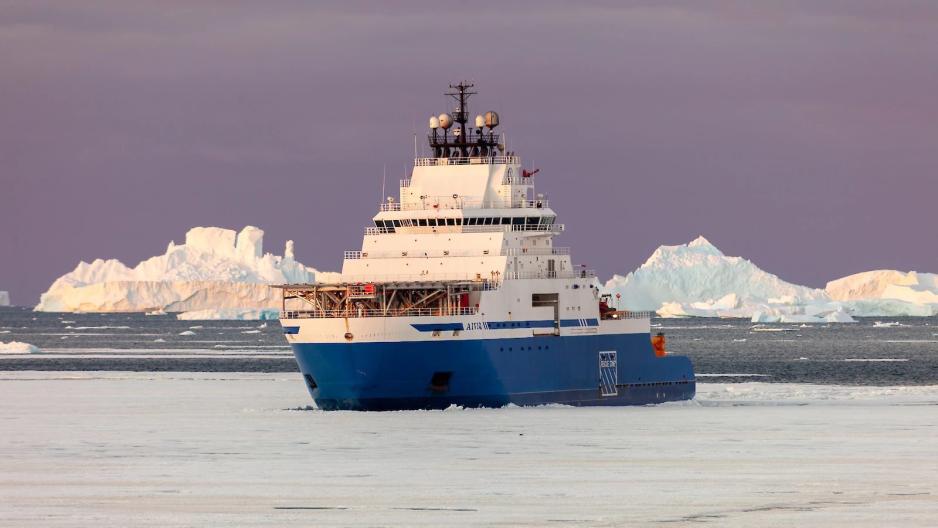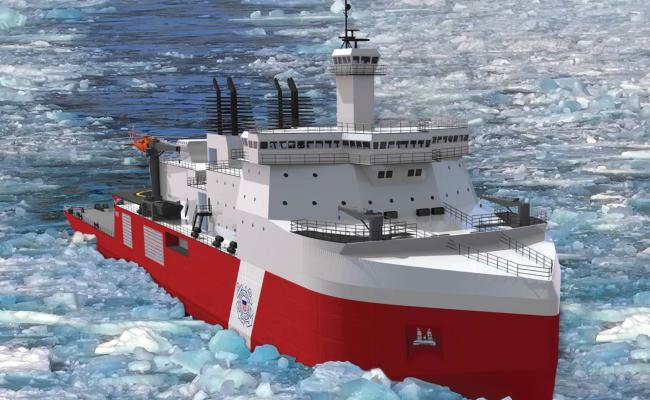U.S. Coast Guard Icebreaker Faces Delays With No Funding Request for 2025, Aims to Acquire Commercial Icebreaker

Artist rendering of the Polar Security Cutter traveling through sea ice. (Source: Halter Marine)
The U.S. Coast Guard did not request additional funding for the Polar Security Cutter icebreaker program in 2025, while it revises the program schedule hinting at further delays. To secure additional icebreaker capacity in the short-term it earmarked $125 million to acquire a commercial icebreaker, likely M/V Aiviq.
The timeline of the U.S. Coast Guard Polar Security Cutter (PSC) program continues to face new uncertainty. The 2025 budget request zeroed out a previous request for $47.2 million.
A Coast Guard spokesperson stated that the service is working to “re-baseline” the program with the goal of devising a new program schedule at some point later this year. The new schedule will be used to “inform future budget requests.”
The program has faced a number of delays since Halter Marine shipyard, now Bollinger Shipyards, was awarded the contract for the first PSC in 2019.
In an update last year the agency announced that the yard had begun initial steel cutting for the first eight modules in August 2023. The effort serves as a test for a specific high-strength steel alloy called EQ47 needed to assemble the full icebreaker hull consisting of 85 modules.
U.S. shipyards have not constructed a heavy polar icebreaker in nearly 50 years.
Latest estimates have pushed this timeline out to 2028.
According to the Coast Guard the acquisition of a fleet of PSC remains a top priority, but the launch of the lead vessel has repeatedly been pushed back. Originally the agency expected to take delivery in 2024.
Latest estimates by the U.S. Government Accountability Office and Coast Guard leadership have pushed this timeline out to 2028.
Given the announcement of an updated program schedule coming later this year further delays appear likely. Experts had previously cautioned that it could well be 2030 before the vessel enters into service.
Acquiring Aiviq also holds pitfalls
In an effort to bridge the ice-breaker gap in the short-term the agency has had ongoing discussion about acquiring a commercially available icebreaker.
However, the need for the vessel to have been constructed in a U.S. shipyard limits the options to essentially a single candidate, American made icebreaking offshore supply vessel M/V Aiviq.

Offshore supply icebreaker Aiviq during operation in Antarctica. (Source: Kirk Yatras via Australian Antarctic Division)
Earlier this month the Coast Guard solicited an offer for a fixed-price contract from the vessel’s owner, Edison Chouest Offshore.
The pending Homeland Security Appropriations Act, part of next year’s budget currently before the U.S. Congress, includes funds for $125 million to acquire an icebreaker seemingly paving the way for the Coast Guard to follow through with its plans.
While the vessel would add capabilities to the service’s aging icebreaker “fleet” consisting of the 48-year old heavy icebreaker Polar Star and the 25-year old medium icebreaker Healy, its suitability for the Coast Guard’s needs has been questioned.
The vessel will require extensive and costly refits to bring it up to the agency’s standards. Alaska Senator Murkowski expects the retrofit to take between 18-24 months.
“And it will take somewhere between 18 months to two years — we’re going to push them on the 18 months — to get this ship transitioned to where the Coast Guard operates it with what they need,” she told the Juneau Empire.
May take significantly longer
It is unclear how such a quick timeline aligns with a requirement in the National Defense Authorization Act, stipulating that any commercial icebreaker the Coast Guard acquires needs to be comparable in scientific capability to icebreaker Healy.

Language specifying requirements for icebreaker acquisition from the National Defense Authorization Act. (Source: U.S. Congress)
Alaska Senator Sullivan cautioned that it would likely take 6-7 years for Aiviq to be fully mission ready.
He explained that the vessel could likely quickly be deployed for search and rescue type missions, but that a full conversion into a scientific platform and a “robust military ship” would take much longer.
Even with the planned acquisition of Aiviq the Coast Guard remains caught between an ice floe and a hard place in terms of icebreaking capabilities, at least in the near to medium term. Aiviq is unlikely to enter into service before 2027.
And with additional delays to the PSC now expected a new heavy icebreaker remains 5-6 years into the future.



